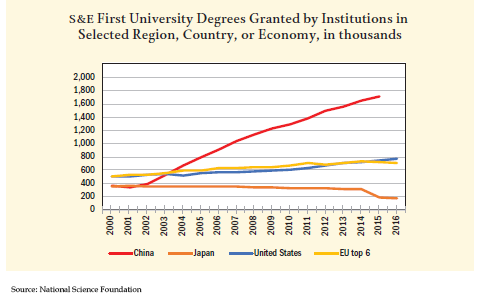
A new report has just been released by the American Academy of Arts and Sciences in conjunction with Rice University’s Baker Institute for Public Policy that addresses America’s relative strength in science, engineering, technology and innovation, including research and development, compared with that of the Peoples Republic of China. Bearing the title “The Perils of Complacency: America at a Tipping Point in Science and Engineering,” the report updates an earlier study and concludes that the modest U.S. lead in science and engineering previously cited is rapidly closing, with China now surpassing the United States in a number of significant indicators. The two reports were prepared by the same group of scientists, engineers, businesspersons and former government leaders.

The new report addresses four measures of scientific and engineering assets: financial capital, human capital, knowledge capital, and the R&D and innovation ecosystem. China has stated its intention to become a leader in a number of fields of science and technology, with particular focus on artificial intelligence—and is devoting funds and talent to do so. The report notes the remarks of Wen Jiabao, former Premier of the State Council of the People’s Republic of China, that “The history of modernization is, in essence, a history of scientific and technological progress. Inventions have brought about new civilizations, modern industries, and the rise and fall of nations… I firmly believe that science is the ultimate revolution.”
America’s total investment in R&D as a fraction of GDP has remained stagnant, in the vicinity of 2.7 percent for nearly a half century, a time during which the impact of science and technology has burgeoned. Other nations, especially China, have accelerated their commitments to science and engineering such that the United States has fallen to tenth place among developed nations in the fraction of GDP devoted to R&D (public and private). While the federal government’s share of the nation’s total R&D spending has declined in recent years from about two-thirds to under one-third, industry, responding to demands for near-term returns, has focused on development rather than research, leaving many of industry’s once-renowned laboratories to decline or even close. The prime example is Bell Laboratories, home of the laser, transistor and 12 Nobel Laureates, the remnants of which are now owned by a Finnish firm.
Particular concern is raised in the report over the future size and quality of the U.S. R&D workforce, given the far greater population of China, its commitment to education and its emphasis on science and engineering. According to the most highly recognized international test of student performance (PISA), U.S. 15-year-olds rank 25th in combined reading, science and mathematics score among the 31 participants in the test. China is now producing over twice as many baccalaureate-level graduates in science and engineering as is the United States, and the number and quality of its universities and research laboratories is steadily increasing.
The report notes the immense contribution to America’s scientific and engineering enterprise that is made by foreign-born individuals who receive their higher education at America’s universities and elect to remain, raise their families and contribute to the nation’s economy and overall wellbeing. In recent years, about one-third of all Ph.D. recipients in science, technology, engineering and mathematics (STEM) awarded by U.S. universities were born abroad. Notably, nearly half of U.S. Fortune 500 companies were founded by immigrants or the children of immigrants. This highlights not only the importance of continuing to attract such individuals to America and encouraging them to remain and contribute, but also to increasing the level of interest and qualifications of America’s youth to pursue careers in science and engineering.
The report concludes with a number of recommendations. These include increasing federal investment in basic research by 50%, from 0.2 to 0.3 percent of GDP, and increasing national investment in R&D (public and private) to 3.3 percent of GDP. It also includes recommendations focused on STEM education, workforce, and policies that are holding back progress in scientific discovery and innovation. It states that failing to accept these or similar actions portends serious consequences for the U.S. economy and national security, particularly given the rapid pace of advances occurring in the fields of science and technology. Of note, it took slightly over 50 years for the automobile to penetrate from 20 to 80 percent of America’s homes; the already ubiquitous iPhone was introduced only 13 years ago.
 Neal Lane is Senior Fellow in Science and Technology Policy at the Baker Institute for Public Policy, and Malcolm Gillis University Professor Emeritus of Physics and Astronomy at Rice University. Earlier, he served as chancellor of the University of Colorado at Colorado Springs, provost of Rice University, Director of the National Science Foundation, and Science Advisor to the President and Director of the Office of Science and Technology Policy.
Neal Lane is Senior Fellow in Science and Technology Policy at the Baker Institute for Public Policy, and Malcolm Gillis University Professor Emeritus of Physics and Astronomy at Rice University. Earlier, he served as chancellor of the University of Colorado at Colorado Springs, provost of Rice University, Director of the National Science Foundation, and Science Advisor to the President and Director of the Office of Science and Technology Policy.
 Norman Augustine is retired Chairman and CEO of Lockheed Martin Corporation and former Under Secretary of the Army, among other positions. He also has served as chairman of the Review of United States Human Space Flight Plans Committee, chairman of the American Red Cross, co-author of the National Academies’ Rising Above the Gathering Storm, and numerous other public service roles. His book, Augustine’s Laws, is widely quoted.
Norman Augustine is retired Chairman and CEO of Lockheed Martin Corporation and former Under Secretary of the Army, among other positions. He also has served as chairman of the Review of United States Human Space Flight Plans Committee, chairman of the American Red Cross, co-author of the National Academies’ Rising Above the Gathering Storm, and numerous other public service roles. His book, Augustine’s Laws, is widely quoted.







Excellent summary of an insightful call-to-arms for preserving America’s leadership in research and technology. I hope that we have not grown deaf.
If we truly want more American youth to enter the “hard” Sciences and Engineering we need to focus less on rah rah feel good STEM courses and focus on teaching our children more about grit and “stick-to-itiveness”. The first two years of Engineering School is still that same weed out that it was 35 years ago when I attended. And high achieving students in high school tend to bail at the first sign of difficulty rather than have it affect their GPA. Even communicating that their starting engineering salary will probably be almost double what their new chosen degree will pay does little to dissuade them. They talk about their college quality of life, and the unreasonable demands of the Engineering course load. It leaves us with few engineering graduates and a whole bunch of non-technical graduates. If you think I am being overly pessimistic, ask your local university about the size of their school or college of Engineering versus the University undergraduate population at large. At UMASS, the Engineering program is in the top 50 nationally, and Engineering is approximately 5% of the total undergraduate population. I agree we need to fix this problem, but I think the biggest problem is that we, as a nation, aren’t teaching our children to value hard work.
Too much of what happens is the ‘feel good’ PR type. The US, like any ‘mature’ system is riding on inertia, past achievements. ONLY a culture change will reverse this closing gap. And perhaps a bit of xenophobia is not bad; we share most all research openly. Many ‘overseas’ student are in advanced research because US doesn’t have enough. They then return to ‘their countries’ – China or India mostly,
Too many students are babied from sn early age. CHANGE must happen from the start. As an overseas grad student in California i took tough first quarter courses because i thought ‘better learn’. But from a neighboring country took, essentially re-took, courses that covered material they had covered thoroughly in undergraduate courses. They got A-Bs; i got my only C in grad school. GPA ‘bumping’.
Two observations: We lost Bell Labs because the government broke up AT&T. We lost IBM Research because the antitrust suit 1975-80 changed IBM’s management goals to no risk taking. Now the government is going after our biggest and best technology companies again. The Universities have done a credible job of research, but it is not enough.
However, losing manufacturing to overseas did the most damage. When we had a strong electronics manufacturing sector U.S. engineers had to practice what they were designing and developing. And they had real time feedback on how the designs worked. And we needed more of them to provide the product engineering and manufacturing engineering needed. So we lost our Research laboratories and our manufacturing plants. Does anyone think design will not disappear next?
Ron Gedney
I agree with @Thomas Barbeau 100%! We need to value teachers, we need to install kids with fortitude, instead of a complacent attitudes towards life.
Great presentation. I enjoyed the insights. The trend has also being a concern to me. Thank you.